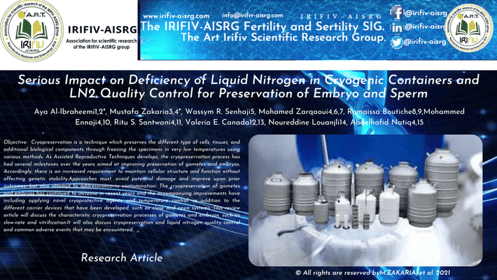Serious Impact of Deficiency of Liquid Nitrogen in Cryogenic Containers and Quality Control for Preservation of Gametes and Embryos

Aya Al-Ibraheemi1,2*, Mustafa Zakaria3,4*, Wassym R. Senhaji5 , Mohamed Zarqaoui4,6,7, Romaissa Boutiche8,9, Mohammed Ennaji4,10, Ritu S. Santwani4,11, Valeria E. Canada12,13, Noureddine Louanjli14, Abdelhafid Natiq4,15
ABSTRACT Cryopreservation is a technique which preserves the different type of cells, tissues, and additional biological components through freezing the specimens in very low temperatures using various methods. As Assisted Reproductive Techniques develops, the cryopreservation process has had several milestones over the years aimed at improving preservation of gametes and embryos. Accordingly, there is an increased requirement to maintain cellular structure and function without affecting genetic stability.Approaches must, avoid potential damage and improve upon prior outcomes, but also attempt to address concerns contamination. The cryopreservation of gametes and embryos has continued to increase in recent years and the accompanying improvements have including applying novel cryoprotective agents and temperature control, in addition to the different carrier devices that have been developed, such as close and open systems. This review article will discuss the characteristic cryopreservation processes of gametes and embryos, such as slow-rate and vitrification.It will also discuss cryopreservation and liquid nitrogen quality control and common adverse events that may be encountered.
Citation: Al-Ibraheemi A, Zakaria M, Senhaji WR,Zarqaoui M, BouticheR, Ennaji M, et al. (2021) Serious Impact of Deficiency of Liquid Nitrogen in Cryogenic Containers and Quality Control for Preservation of Gametes and Embryos. J Fertil In vitro IVF WorldwReprod Med Genet Stem Cell Biol 9:234.